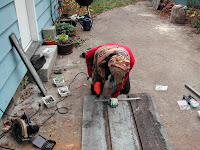



this is our first year collecting seeds, so we're still figuring out the plants ourselves. most garden plants will bud, flower,and produce seed. in some plants the seeds are in the fruit, and other plants don't produce fruit at all. a good rule of thumb is that the seed is ready if you can't put your fingernail through it- the seed should be hard. these are the plants we collected seed from, or are in the process thereof....
lettuce: lettuces will bolt, which means they start growing upwards rapidly and become bitter tasting. they typically bolt as the season gets warmer. you'll want to collect seed from the late bolting plants, to promote the trait of late bolting in future plants. after the lettuce has bolted (and the plants can get very tall), it will begin flowering. while flowering the plant will be visited by various nectar collecting insects. the flowerheads will turn white and fluffy. the fluffy cottony part is called papis. when about 3/4 of the flowers turn to papis pull the plant out of the ground. keep the plant upside down in a paper bag, and set in the sun until plant is completely dried out. this takes around a week. after it's dried, shake the plant over a bag, screen, anything to catch the seeds. pull any remaining seeds from the flower heads. lettuce seeds are very tiny and thin. their colors can range from black to brown to a dark tan.
marigold: simply let the plant flower, and don't dead-head. once the flower is dead, it will dry out on the stalk. the seeds will be in the old flower head. split the flower head open, and the seeds will be easy to shake into your hand.
calendula: again, let the plant flower, and don't remove the flower. it will dry up and leave curved rough seeds on the old flower head. collect them when they are hard.
nasturtium: after the plant flowers it will produce a roundish green seed. it will turn dark brown and hard when it is ready to be collected.
morning glory: after the plant flowers it will produce a greenish fruit. this will dry up and become brown. when you put pressure on the fruit, it should pop open, not squish. if it squishes, the seed is not ready. if it pops open then the seed is ready.
garlic: wait until the stalks are dying and turning brown and pull the garlic head up. this is when you would normally harvest it. set aside the heads you want to replant, and hang in a dark dry place until next season. break up the garlic head, and plant the cloves individually.
tomato: pick the ripe fruits that posess the traits you desire. slice the tomato down the middle, lengthwise, and scoop out the seeds. place the seeds in a ceramic or wooden bowl. add enough water to cover the seeds. set aside in the shade for a day, this should allow most of the pulp to seperate from the seeds. rinse the seeds off in a strainer. place the seeds back in a bowl, cover with water again, and set aside for another day. this should remove the remainder of the pulp. rinse the seeds again, then place them on a drying cloth. once dry, place in a storage container.
broccoli: broccoli heads will go to flower, and then take a long time to form thin pods, called siliques. then the pods will take a long time to mature. once the pods toward the bottom of the plant start to open, pull the entire plant up and place upside down in a paper bag. leave in a warm dry place, until the plant is dried up. rub the pods against a small screen to seperate the small round seeds from the chaffe.
cucumber: another lengthy process. the fuits produced later, usually have more seeds. select the cucumbers you want to save seed from, and allow them to ripen on the vine. they will turn a yellowy orange color. once the cucumber becomes mushy, pick it from the vine. cut the cucumber lenghtwise and scoop out the seeds. like the tomatoes, place the seeds in a wooden or ceramic bowl and add a bit of water. allow the seeds to ferment for a few days, and stir them every once in a while. when draining the seeds, the good seeds will stay at the bottom. discard the other seeds with the pulp. place the good seeds on a screen to dry. after two or three days, they are ready to store.
beans: all bean seeds can be collected in this manner, except for mung beans. allow the selected bean pods to dry on the vine. pick before the first frost. remove the beans from the pod. allow the beans to dry for a month, and then store. keep the drying beans in a warm dry area.
a good book on seed collection is "Compleatly Self-Sufficient Food-Plant Propagation" by Herm Fitz.















